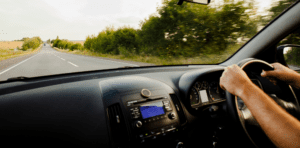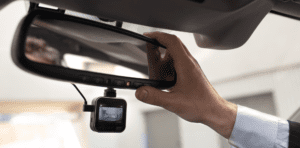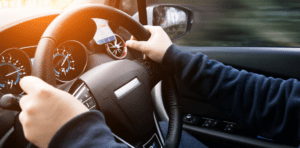Compare cheap car insurance
✔ Compare cheap car insurance quotes
✔ Over 110 insurance providers
✔ Get a quote in minutes
✔ Save up to £504*
Heavy rain and wet roads pose various challenges for drivers. Follow these tips to ensure safety while driving in wet conditions.
- Why rain and wet cause accidents
- Check your windscreen
- Check your tyres
- Turn on your headlights
- Fill up on fuel
- Turn on your air conditioning
- Know your stopping distances
- Watch out for deep puddles
- Frequently asked questions
Why rain and wet cause accidents
Wet weather is a major cause of road accidents, with rain increasing the risk of a collision nine-fold according to statistics from the Met Office. There are several reasons why rain and wet roads are so hazardous for drivers:
- Reduced tyre grip – Water on the road surface reduces friction between tyres and the road, making it harder for tyres to grip. This makes it easier to lose control, especially when braking or turning.
- Impaired visibility – Heavy rain obscures vision and makes it harder for drivers to see vehicles, pedestrians, road signs, and hazards. Raindrops on windshields also reduce visibility.
- Increased stopping distances – With less tyre grip, vehicles take longer to come to a halt when braking in the rain. Recommended stopping distances in wet conditions are at least double those of dry conditions.
- Aquaplaning – At high speeds, water can build up under tyres so that they are no longer in contact with the road surface. This leads to a complete loss of traction and control.
- Spray from other vehicles – Large vehicles and high speeds produce spray and mist behind moving vehicles, further reducing visibility for other drivers.
- Slippery surfaces – In addition to wet roads, painted lines, metal covers and oil patches become extremely slippery when wet. This surprises drivers and leads to sudden losses of control.
- Driver behaviour – Many drivers do not adjust their speed and following distances to suit wet conditions. As a result, stopping distances are inadequate to prevent collisions.
Climate change is increasing rainfall in the UK, with the years 2011-2020 recording 9% more precipitation on average than 1961-1990. With wetter weather becoming the new normal, drivers need to be prepared to handle rain year-round.


Staying safe means slowing down, increasing following distance, avoiding aquaplaning, and generally driving more cautiously in the rain.
How much can you save on your car insurance?
Check your windscreen
Driving in the rain starts with being able to see clearly through your windscreen. A dirty or smeared windscreen severely reduces visibility, so take the time to thoroughly clean all glass inside and out before getting on the road.
Eliminate any grime, fingerprints, or residue with a good cleaning to ensure you have an unobstructed view.
You’ll also want to be sure your windscreen wipers are in good working order. Inspect the wiper blades for cracks, tears or signs of wear.
Damaged wiper blades cannot provide a clear view, leaving streaks and smears when you need to see most.
Replace any blades that are worn out. Check that your wiper fluid reservoir is topped up with quality fluid formulated for wet weather driving. This helps blades glide and removes dirt from the windscreen.
Finally, check the operation of the wipers. Make sure they fully clear water from the windscreen with no skipped spots or juddering. Adjust any settings so blades make firm contact with the glass.
Taking a few minutes to get your windscreen and wipers ready for the weather can greatly improve visibility and safety when driving in the rain. Being proactive keeps your view clear so you can see and be seen on wet roads.
How much can you save on your car insurance?
Check your tyres
Driving in heavy rain exposes your vehicle to the risk of “hydroplaning” or “aquaplaning”, a hazardous phenomenon where your tyres lose direct contact with the road due to a layer of water, resulting in loss of control over the vehicle.
When caught in a situation where steering becomes unresponsive, it’s advised to gently lift your foot off the accelerator, decelerating slowly without applying the brakes. This approach allows your tyres to regain traction without causing a sudden shift in vehicle dynamics, which can be dangerous.
To minimise the risk of hydroplaning, proactive tyre maintenance is essential. Begin by examining your tyres’ tread depth (minimum legal tread depth in the UK is 1.6mm). Tread depth is crucial for channelling water away, and a deeper tread is more effective in preventing water from coming between the tyre and the road.
Tyres with worn or shallow treads are significantly more prone to hydroplaning as they offer less resistance to water penetration.
Additionally, maintain your tyres at the correct pressure. Under-inflated tyres tend to have a distorted shape that might not facilitate effective water displacement, while over-inflated ones reduce the tyre’s contact patch with the road, both increasing the risk of losing traction.
Regularly check your tyre pressures, adjusting them as necessary to match the manufacturer’s specifications, which can typically be found in your vehicle’s manual or on a sticker inside the driver’s door.
Inspect your tyres for any visible signs of damage or wear, such as cuts, bulges, or punctures. Damaged tyres are not only more susceptible to hydroplaning but also to blowouts and flats, all of which are particularly dangerous when driving at speed in wet conditions.
Replace any tyre that shows signs of excessive wear or damage immediately to ensure you have the best possible grip and control when driving in the rain.
Taking these preventative measures not only enhances your safety during wet weather driving but also extends the life of your tyres, providing a smoother and more controlled driving experience in all conditions.
How much can you save on your car insurance?
Turn on your headlights
In wet weather conditions, visibility often deteriorates, sometimes significantly, even during the daylight hours. Therefore, turn on your headlights to enhance your vehicle’s visibility to other road users.
Illuminating your headlights makes your vehicle more noticeable and discernible from the surroundings, assisting other drivers in accurately judging your vehicle’s position, speed, and direction, thereby reducing the risk of collisions.
Adopting the practice of turning on headlights whenever your windscreen wipers are in operation is highly advisable. This habit ensures that your lights are activated in all forms of precipitation, be it light drizzles, heavy rain, or snow, which invariably lead to compromised visibility.
In many jurisdictions, this practice isn’t just a recommendation; it’s mandated by law to have your headlights turned on under such circumstances for safety reasons.
It’s also prudent to regularly check and ensure that all your vehicle lights, including headlights, brake lights, and turn signals, are functioning correctly. Faulty or non-operational lights can severely impede your visibility to others on the road, especially in wet conditions where visibility is already compromised.
Promptly replace any burnt-out bulbs or repair malfunctioning light systems. The aim is to maintain optimal visibility and communication with other drivers, so ensure your vehicle is equipped to do so under all weather conditions.
Additionally, consider the type of headlights your vehicle is equipped with. For instance, vehicles with LED or HID headlights typically offer better illumination and visibility compared to traditional halogen lights.
Upgrading your headlights to more advanced and brighter options might be a worthwhile investment for enhanced safety while driving under poor visibility conditions, like those encountered during wet weather.
By taking these measures, you ensure not only your safety but also contribute to the overall safety on the roads, making it easier for everyone to navigate through challenging wet weather driving conditions with confidence and security.
How much can you save on your car insurance?
Fill up on petrol (or make sure your electric vehicle is fully charged)
Rainy weather tends to exacerbate traffic conditions, leading to slower-moving traffic and, consequently, extended travel times. This slow pace can inadvertently result in higher fuel consumption for traditional petrol or diesel vehicles, as engines often operate less efficiently in stop-and-go traffic.
For electric vehicle (EV) users, the energy consumption can also increase due to the use of various systems like heating, lighting, and windshield wipers, which are frequently used in wet conditions. Hence, ensuring that your vehicle has ample fuel or is fully charged is paramount to avoid being stranded on the road in inclement weather.
Prior to embarking on your journey, make it a routine to check your fuel gauge or battery status. If you notice that the fuel level is low or the battery charge is insufficient for the distance you plan to cover (considering the possibility of heavy traffic), take time to refuel or recharge.
For those driving petrol or diesel vehicles, having a full tank not only provides peace of mind but also reduces the necessity to stop at a fuel station amidst a downpour, thus allowing for a more comfortable and uninterrupted journey.
It’s wise to refill your tank once it reaches a quarter full, as this practice also prevents potential issues related to fuel pumps and fuel filters, ensuring that your vehicle runs smoothly.
Electric vehicle drivers should also be vigilant about their charge status. Given that recharging stations might not be as ubiquitously available as petrol stations, planning your route to include a charging station, if needed, is prudent.
Make use of apps or in-built navigation systems that provide real-time information on the location and availability of charging stations, helping you plan your stops efficiently.
It’s worth noting that cold and wet weather can impact the efficiency of your vehicle’s battery, whether it’s a traditional lead-acid battery in combustion-engine vehicles or the lithium-ion batteries found in EVs.
Battery capacity can diminish in low temperatures, so taking precautions to ensure your vehicle is prepared for the journey is imperative.
By being proactive and ensuring your vehicle is adequately fuelled or charged, you not only secure a hassle-free drive but also safeguard yourself from the inconvenience and potential danger of running out of fuel or charge in adverse weather conditions.
How much can you save on your car insurance?
Turn on your air conditioning
Using the air conditioning (air con) system in your vehicle is a proactive measure to prevent the windscreen from fogging up when it’s raining.
Foggy windows occur due to the disparity in temperature between the cold windscreen and the warmer, humid air inside the vehicle.
This temperature differential causes condensation to form on the interior surface of the windscreen, obstructing the driver’s view.
Turning on the air conditioning system helps mitigate this issue by regulating the interior air temperature and reducing humidity levels.
The air con generates dry air, which effectively absorbs the moisture within the vehicle’s cabin, thus preventing condensation on the windows and windscreen.
Set the air conditioning system to blow towards the windscreen and windows for optimal defogging results.
Alternatively, if you prefer not to use air conditioning or if your vehicle is not equipped with it, cracking open the windows can also aid in ventilating the interior and equalising the temperature and moisture levels with the external environment.
This natural ventilation method can be effective, albeit possibly less comfortable in very cold or wet conditions.
Another unconventional but often touted method to keep the windscreen clear of fog is the application of shaving foam. By applying a thin layer of shaving foam to the inside of the windscreen and then wiping it off, you create a protective layer that helps to prevent fogging.
The shaving foam acts as a surfactant, reducing the surface tension of water and making it harder for condensation to adhere to the glass. However, care should be taken to apply it properly to avoid creating a smeary or blurry windscreen.
Ensuring a clear field of vision is paramount for safe driving, especially in rainy conditions where visibility is already compromised. Taking preventive measures to maintain a fog-free windscreen can significantly enhance your safety and comfort while driving in wet weather.
Always consider combining these methods as necessary, adapting to the specific conditions you encounter on the road, to guarantee an unobstructed view at all times.
How much can you save on your car insurance?
Know your stopping distances
When driving in rainy conditions, your vehicle’s stopping distance— the total distance covered from perceiving a threat to coming to a complete halt—will inevitably increase compared to dry weather driving.
This extended stopping distance is due to a combination of increased thinking distance and braking distance in wet conditions.
Thinking distance refers to the distance your car travels in the time it takes for the driver to register a hazard and decide to brake. Reduced visibility in rainy weather can delay your reaction time as hazards become harder to identify, thereby extending the thinking distance.
It’s essential to stay extra vigilant and focused on the road to minimize this delay.
The braking distance is the distance covered from when the brakes are first applied to when the vehicle stops completely. Wet and slippery roads diminish the tyres’ grip and traction, leading to longer braking distances.
In some cases, the braking distance can even double on wet roads compared to dry ones. The tyres struggle to maintain the same level of adhesion on wet surfaces, hence the need to adjust your driving style accordingly.
Given these factors, you should maintain a safe following distance from the vehicle in front of you, allowing yourself ample time and space to respond to emerging hazards.
Adopting a defensive driving approach, which includes reducing speed, avoiding sudden manoeuvres, and being prepared for the unexpected, is key to safely navigating through rain-soaked roads.


Checking the tread depth of your tyres regularly is also vital, as deeper treads are more effective in dispersing water, providing better traction on wet surfaces.
In addition, if your vehicle is equipped with anti-lock braking systems (ABS), familiarise yourself with how they feel and respond in wet conditions, as ABS can assist in maintaining steering control during an emergency stop.
Drivers should practice gentle and gradual braking to prevent skidding and loss of control.
By understanding and respecting the increased stopping distances required on wet roads, drivers can significantly enhance their safety, as well as the safety of others sharing the roadway, during rainy weather.
How much can you save on your car insurance?
Watch out for deep puddles
Navigating through deep water puddles while driving can lead to various risks, including the perilous phenomenon of aquaplaning and potential vehicle breakdowns.
Deep puddles can also lead to mechanical malfunctions, especially if water enters the engine compartment, exhaust, or other sensitive components, causing the vehicle to stall or suffer damage.
Beyond these immediate concerns, deep puddles can conceal underlying threats, such as potholes, debris, or even submerged objects, which may not be visible on the surface but can inflict damage to your vehicle’s tyres, wheels, or undercarriage upon impact.


These hidden hazards can lead to immediate or eventual vehicle failures and may necessitate costly repairs.
When encountering deep puddles, adopting a cautious and deliberate approach is crucial. If you must traverse a waterlogged area, proceed with low speed and maintain a steady throttle to avoid splashing water into the engine bay or onto other vehicles and pedestrians.
Observing other vehicles and their passage through the puddle may provide insights into the depth and the presence of hidden obstacles. Additionally, be courteous to pedestrians by avoiding splashing water onto walkways or sidewalks.
Should your vehicle unfortunately stall or break down in or after passing through a deep puddle, it’s generally advisable to remain inside, provided you are in a safe location away from the flow of traffic.
Exiting the vehicle in a traffic area, especially with reduced visibility during rain, can expose you to the risk of being struck by other vehicles. Once safe, call for assistance through a roadside assistance service or emergency number.
Always have a fully charged mobile device and the necessary contact information for emergency services to ensure you can call for help when needed.
In cases where your vehicle is safely parked and not posing a risk to you or other road users, awaiting professional help within the safety of your car is the most prudent course of action. This approach ensures you are shielded from the elements and other potential risks while help is en-route.
How much can you save on your car insurance?
Frequently asked questions
As incidents of heavy rain and flooding become more frequent, ensure your car insurance provides cover for flood damage. If you have comprehensive insurance, flood damage is typically included.
However, if your policy is limited to third-party fire and theft, you might need to consider getting additional cover for flood damage.
Driving in the rain can potentially damage your car’s engine. If your car breaks down during heavy rain, keep the bonnet closed to prevent water from entering the engine.
In such a scenario, it’s advisable to stay inside your vehicle and call for assistance.
Splashing pedestrians by driving quickly through puddles not only irritates those walking but is also illegal.
Deliberately soaking pedestrians amounts to careless and inconsiderate driving, which violates the Road Traffic Act of 1988. Committing this offence could result in fines up to £5,000.
Car insurance blog
Video by Kelly










